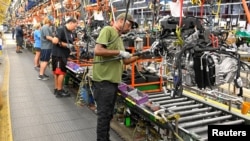U.S. gross domestic product rose at an annual rate of 2.6 percent in the July to September period, according to the latest Commerce Department data.
The surge came after the U.S. economy shrank 0.6 percent in the second quarter, according to revised numbers, after a larger decline in the first three months this year.
"Our economic recovery is continuing to power forward," said President Joe Biden in a statement.
But officials need to "make more progress" on bringing down high costs for American households, he added.
The better-than-expected GDP performance was helped by strong trade, even as housing investment plunged and weaker consumer spending on goods casts a pall on growth as higher prices bite.
Industrial supplies and materials, notably petroleum and products, kept exports robust.
However, Ian Shepherdson of Pantheon Macroeconomics. thinks the leap in exports is "unsustainable," as a strong dollar and weak global growth will pose constraints moving forward.
Meanwhile, in consumer spending, an increase in services was "partly offset" by a drop in products like motor vehicles and parts, along with food and beverages, data showed.
Overall, personal consumption expenditures -- a key segment of the economy -- grew 1.4 percent, slower than before.
While there is still some momentum in household spending and a rebound in business investment, there is also "ongoing weakness in residential investment," stated Rubeela Farooqi of High Frequency Economics.
Households have been reeling from decades-high inflation, with prices soaring on supply chain snarls due to Covid-19 lockdowns and fallout from Russia's invasion of Ukraine, which sent food and energy costs rocketing.
Republicans have blamed Democrats for worsening price spikes through runaway spending, though inflation is a global issue that presidents have limited power over.
To lower price pressures, the US central bank has embarked on aggressive rate hikes, walking a tightrope as it tries to avoid tipping the economy into a recession.
Policymakers are expected to press on with rate increases at a meeting next week, in the face of persistently high prices.
While rate hikes are used to "cool" inflation, they also drive up mortgage interest rates, with the U.S. "Freddie Mac" noting the 30-year fixed rate has now crossed above seven percent. That, in turn, has dampened some of the market frenzy that saw "cheap money" helping to send home prices rocketing in the past year before the rate hikes made impact.




